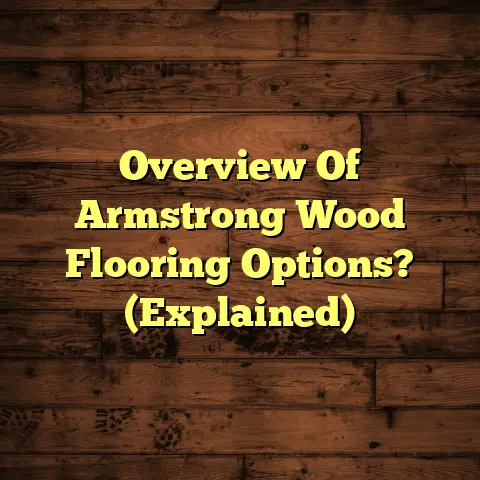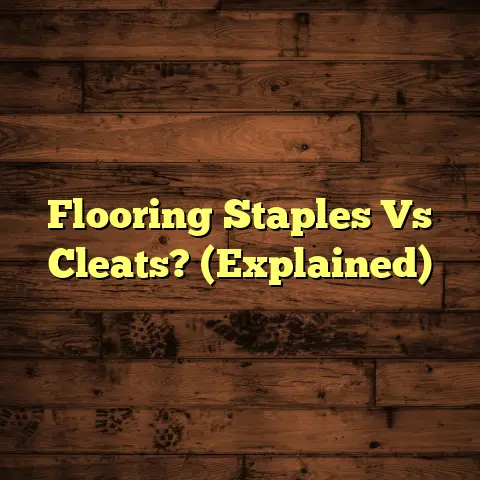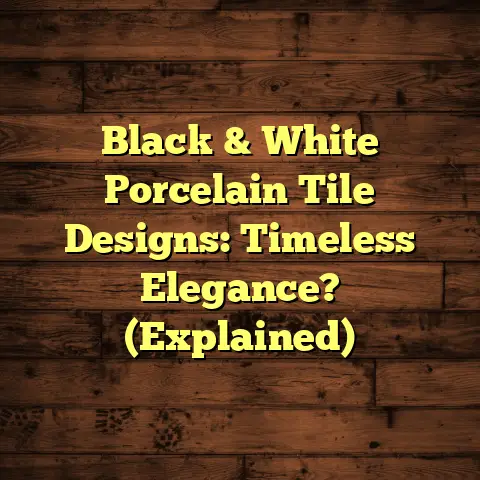Fix Vinyl Plank Scratches? (3 Subfloor Secrets!)
But let’s be real: even the toughest VPF is no match for a hyperactive dog, a rogue chair leg, or a kid with a toy truck. Scratches happen.
Now, you might be thinking, “Ugh, I’m going to have to replace the whole floor!” Hold on a minute! Before you start ripping things up, let me tell you a secret: fixing those scratches is often way easier (and cheaper) than you think.
And here’s another secret: the key to both fixing and preventing scratches often lies beneath the surface – in your subfloor.
In this article, I’m going to share my insider knowledge on how to fix those annoying scratches on your VPF and, more importantly, how to make sure they don’t keep coming back. We’ll dive into the secrets of the subfloor and how it plays a crucial role in protecting your investment.
Section 1: Understanding Vinyl Plank Flooring and Its Vulnerabilities
So, what exactly is vinyl plank flooring? Well, it’s not your grandma’s linoleum. VPF is a multi-layered synthetic flooring product designed to mimic the look of hardwood, tile, or stone.
It’s typically composed of these layers:
- Wear Layer: This is the top layer, the one you walk on. It’s a clear, protective coating that resists scratches, stains, and wear. The thicker the wear layer, the more durable the plank.
- Print Layer: This layer contains the high-definition image that gives the plank its realistic wood or tile look.
- Core Layer: This is the main body of the plank, usually made of PVC (polyvinyl chloride) or a composite material. It provides stability and waterproof properties.
- Backing Layer: This bottom layer provides additional stability and cushioning.
While that wear layer is tough, it’s not invincible. Everyday activities can take their toll. Here are some common culprits:
- Furniture: Dragging chairs, tables, or sofas across the floor is a surefire way to create scratches.
- Pet Claws: Our furry friends can unintentionally damage flooring, especially when they get excited.
- Dirt and Grit: Tiny particles of dirt, sand, or gravel can act like sandpaper underfoot, scratching the surface over time.
- High Heels: Those stilettos might look fabulous, but they can leave dents and scratches on softer vinyl planks.
Here’s a table showing the typical wear layer thickness and its corresponding durability:
| Wear Layer Thickness (mils) | Durability | Recommended Use |
|---|---|---|
| 6-12 mils | Good for light residential use. Offers basic scratch and stain resistance. | Bedrooms, guest rooms, or areas with low foot traffic. |
| 12-20 mils | Suitable for most residential applications. Provides better scratch and stain resistance than thinner wear layers. | Living rooms, dining rooms, kitchens (with proper care), and hallways. |
| 20+ mils | Excellent durability for high-traffic residential or light commercial use. Highly resistant to scratches, dents, and stains. | Commercial spaces (offices, retail stores), busy households with children and pets, or areas where spills and accidents are common. |
Ignoring Scratches: A Costly Mistake
So, what’s the big deal about a few scratches? Well, for starters, they make your floor look old and worn. But more importantly, scratches can weaken the wear layer, making the plank more vulnerable to stains, moisture damage, and further wear.
Over time, those small scratches can turn into larger, more noticeable blemishes. And once the damage reaches the print layer, there’s no turning back. You’re looking at either a costly repair or a full-blown floor replacement.
According to a 2023 report by HomeAdvisor, the average cost to replace vinyl plank flooring is between \$3 to \$10 per square foot, including materials and labor. That can add up quickly!
That’s why a proactive approach to flooring maintenance is key. By addressing scratches early on, you can prevent them from escalating into more serious problems and save yourself a lot of money in the long run.
Section 2: Assessing the Condition of Your Subfloor
Okay, now let’s talk about the unsung hero of your flooring system: the subfloor. The subfloor is the foundation upon which your vinyl plank flooring rests. It provides a stable, level surface that supports the planks and helps them withstand everyday wear and tear.
Think of it like this: if your subfloor is uneven, damaged, or unstable, it’s like building a house on a shaky foundation. Your flooring is going to suffer the consequences.
Here are three key subfloor secrets that can help you fix and prevent scratches on your vinyl plank flooring:
Secret #1: Proper Subfloor Preparation
Before you even think about laying down your vinyl planks, you need to make sure your subfloor is properly prepared. This means:
- Cleaning: The subfloor must be free of dust, dirt, debris, and any old adhesives. I recommend vacuuming thoroughly and then wiping down the surface with a damp cloth.
- Leveling: The subfloor needs to be as level as possible. Even small dips or bumps can cause the vinyl planks to flex and bend, leading to scratches and other damage.
- Moisture Testing: Use a moisture meter to check the moisture content of the subfloor. Elevated moisture levels can lead to mold growth and adhesive failure.
- Repairing: Any cracks, holes, or damaged areas need to be repaired before installing the flooring.
Cost-Effective Methods for Subfloor Preparation
- Leveling Compound: Self-leveling compound is a pourable mixture that fills in low spots and creates a smooth, level surface. It’s relatively easy to use and can be a lifesaver if your subfloor is significantly uneven. A 50 lb bag of self-leveling compound typically costs between \$20 and \$40 and can cover approximately 50 square feet at a 1/8-inch thickness.
- Plywood Underlayment: If you have a wood subfloor with minor imperfections, you can install a layer of plywood underlayment. This will create a smooth, stable surface for your vinyl planks. A 1/4-inch thick sheet of plywood underlayment typically costs between \$15 and \$30 per sheet.
- Moisture Barrier: If your subfloor is prone to moisture, install a moisture barrier before laying down your vinyl planks. This will prevent moisture from seeping up and damaging the flooring. A roll of polyethylene moisture barrier typically costs between \$20 and \$50 and can cover several hundred square feet.
Secret #2: Choosing the Right Underlayment
Underlayment is a thin layer of material that is installed between the subfloor and the vinyl plank flooring. It provides a number of benefits, including:
- Cushioning: Underlayment adds a layer of cushioning that makes the floor more comfortable to walk on.
- Sound Absorption: Underlayment can help to reduce noise transmission, making your home quieter.
- Moisture Resistance: Some types of underlayment provide a barrier against moisture, protecting your vinyl planks from water damage.
- Scratch Protection: A good underlayment can help to prevent scratches by providing a buffer between the subfloor and the vinyl planks.
Types of Underlayment and Their Cost Implications
- Foam Underlayment: This is the most common type of underlayment. It’s affordable, easy to install, and provides good cushioning and sound absorption. Foam underlayment typically costs between \$0.20 and \$0.50 per square foot.
- Cork Underlayment: Cork is a natural, sustainable material that provides excellent cushioning, sound absorption, and moisture resistance. It’s more expensive than foam underlayment but offers superior performance. Cork underlayment typically costs between \$0.80 and \$1.50 per square foot.
- Rubber Underlayment: Rubber underlayment is the most expensive option, but it provides the best cushioning, sound absorption, and moisture resistance. It’s ideal for high-traffic areas or homes with multiple floors. Rubber underlayment typically costs between \$1.50 and \$3.00 per square foot.
Tips for Selecting the Right Underlayment
- Consider your budget: Underlayment costs can vary widely, so it’s important to set a budget before you start shopping.
- Think about your needs: Do you need extra cushioning? Sound absorption? Moisture resistance? Choose an underlayment that meets your specific needs.
- Read reviews: Before you buy, read online reviews to see what other people have to say about the underlayment you’re considering.
Secret #3: Ongoing Subfloor Maintenance
Even if you’ve properly prepared your subfloor and installed the right underlayment, it’s important to maintain it over time. This means:
- Regular Inspections: Inspect your subfloor regularly for signs of moisture damage, cracks, or other problems.
- Moisture Control: Keep your subfloor dry by addressing any leaks or spills promptly. Use a dehumidifier in damp areas.
- Protecting High-Traffic Areas: Use area rugs or mats in high-traffic areas to protect your vinyl planks from scratches and wear.
Cost-Effective Maintenance Tips
- Routine Cleaning: Regularly sweep or vacuum your vinyl plank flooring to remove dirt and debris.
- Proper Furniture Placement: Use furniture pads under the legs of your furniture to prevent scratches.
- Prompt Spill Cleanup: Clean up spills immediately to prevent staining and moisture damage.
Section 3: Cost-Effective Methods for Repairing Scratches on Vinyl Plank Flooring
Alright, let’s get down to business. You’ve got scratches on your vinyl plank flooring, and you want to fix them without breaking the bank. Here are three cost-effective methods you can try:
Method 1: Using a Vinyl Repair Kit
Vinyl repair kits are designed specifically for fixing scratches, gouges, and other damage on vinyl flooring. They typically include a variety of fillers, colorants, and applicators that you can use to conceal the damage.
Materials Needed:
- Vinyl repair kit (available at most hardware stores for around \$20-\$40)
- Clean cloth
- Utility knife (optional)
Step-by-Step Instructions:
- Clean the area: Use a clean cloth to remove any dirt or debris from the scratched area.
- Prepare the filler: Follow the instructions in your vinyl repair kit to prepare the filler. This usually involves mixing different colorants to match the color of your flooring.
- Apply the filler: Use the applicator provided in the kit to apply the filler to the scratch. Overfill the scratch slightly.
- Remove excess filler: Use a utility knife or the edge of a credit card to carefully remove any excess filler.
- Cure the filler: Allow the filler to cure according to the instructions in your kit. This may involve using a heat gun or simply waiting for the filler to air dry.
- Buff the area: Once the filler is cured, use a clean cloth to buff the area and blend it in with the surrounding flooring.
Tips for Color Matching
- Test the color: Before you apply the filler to the scratch, test it on an inconspicuous area of your flooring to make sure the color matches.
- Mix small batches: Mix small batches of filler at a time to avoid wasting material.
- Use natural light: Color matching is best done in natural light.
Method 2: Heat and Pressure Techniques
This method works best for shallow scratches that haven’t penetrated the wear layer. The idea is to use heat to soften the vinyl and then apply pressure to smooth out the scratch.
Materials Needed:
- Hair dryer or heat gun
- Clean cloth
- Heavy object (e.g., book, weight)
Step-by-Step Instructions:
- Clean the area: Use a clean cloth to remove any dirt or debris from the scratched area.
- Apply heat: Use a hair dryer or heat gun to gently heat the scratched area for a few seconds. Be careful not to overheat the vinyl, as this could cause damage.
- Apply pressure: Place a clean cloth over the heated area and then place a heavy object on top of the cloth.
- Let it cool: Allow the area to cool completely before removing the heavy object and cloth.
- Inspect the area: Check to see if the scratch has been reduced or eliminated. If not, repeat the process.
Tools Required:
- Hair dryer or heat gun (around \$20-\$50)
- Clean cloth
- Heavy object
Method 3: DIY Touch-Up Paints and Sealants
If you can’t find a vinyl repair kit that matches the color of your flooring, you can try using touch-up paints or sealants specifically designed for vinyl flooring.
Materials Needed:
- Touch-up paint or sealant (available at most hardware stores for around \$10-\$20)
- Small paintbrush
- Clean cloth
Step-by-Step Instructions:
- Clean the area: Use a clean cloth to remove any dirt or debris from the scratched area.
- Apply the paint or sealant: Use a small paintbrush to carefully apply the paint or sealant to the scratch.
- Remove excess paint or sealant: Use a clean cloth to remove any excess paint or sealant from the surrounding area.
- Allow it to dry: Allow the paint or sealant to dry completely according to the instructions on the product label.
DIY Options
While I always recommend using products specifically designed for vinyl flooring, some folks have had success with DIY touch-up solutions. Here’s one recipe you can try at your own risk:
- Mix acrylic paint with clear polyurethane: Find an acrylic paint that closely matches the color of your flooring. Mix it with clear polyurethane in a small container. Apply the mixture to the scratch with a small brush and allow it to dry completely.
Important Note: DIY solutions can be tricky, and they may not always provide the best results. Always test the solution on an inconspicuous area of your flooring before applying it to the scratch.
Conclusion
So, there you have it! My insider secrets on fixing scratches on your vinyl plank flooring and, more importantly, preventing them in the first place. Remember, a little bit of preventative maintenance can go a long way in protecting your flooring investment.
By understanding the vulnerabilities of vinyl plank flooring, assessing the condition of your subfloor, and using cost-effective repair methods, you can keep your floors looking beautiful for years to come.
Don’t let those scratches get you down. Take action today and empower yourself with the knowledge to maintain your flooring investment effectively.
Now, go get those floors looking their best! You got this!




